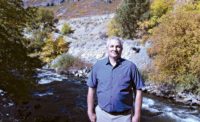Former National Football League head coach and current ESPN analyst Herm Edwards once spoke to incoming rookie players and imparted some advice about staying out of trouble.
“Nothing good happens after midnight,” Edwards reportedly said during the 2011 NFL Rookie Symposium.
John Gregory Williams, P.E., and pme’s 2015 Mechanical Engineer of the Year, is glad he did not receive that instruction growing up. Otherwise it is entirely possible he may not be currently designing the HVAC and mechanical systems for the NFL’s Atlanta Falcons state-of-the-art stadium, slated to open for the 2017 season.
As a teenager in his hometown of Ramsgate, Kent, U.K., Williams — who works for global engineering firm WSP | Parsons Brinckerhoff remotely from his Mexico City residence when not making site visits or dropping in at the company’s San Francisco offices – was up late, flipped to BBC2 and took in an “Open University” program. OU is a public distance learning and research university in the United Kingdom with programs that cover a variety of topics. The programs aired late at night so people could record them and do the corresponding work at convenient times for credit.
This fateful night the OU program was on low-energy buildings and it highlighted the Inland Revenue Building in Nottingham.
Williams was enthralled.
“I remember being absolutely glued to the television,” he says. “It kept me up until three in the morning or something.”
Then Williams began to prepare for his university education, which is different in England than the United States. In England, students go into university with their field of study selected beforehand. Williams knew he was strong in mathematics and physics. He admits he did not quite know what engineering was at the time, but understood the sense of pride one feels after creating something given he would work in the kitchen of the pubs his parents operated over the years.
“I liked how at the end of a shift, after cooking so many dinners, people were happy,” he says. “I had produced something. So I started putting it all together. I picked mechanical engineering purely because it seemed to have the most breadth. From there you may go and work in any industry.”
Then during a tour of the University of Manchester, Williams received a brochure from the Institute of Mechanical Engineers listing companies that provided sponsorships. Williams applied to all the companies and received an interview at global engineering firm Arup.
Who interviewed Williams that day? Just the engineer of the Inland Revenue Building featured on that late-night television program. “It was absolute stroke of luck,” Williams says. “He just loved that I knew all about his most prestigious building.”
Williams’ interview went extremely well and he got the job with Arup and took a gap year before starting his studies at the University of Manchester. After graduation in 2002, Williams rejoined Arup and launched his career that includes design work on some of the world’s most impressive buildings.
Creature of comfort
At the new Atlanta Falcons facility — the Mercedes-Benz Stadium — Williams is in his element with the design.
“So often we think about energy. Energy does not drive anything. Energy is the outcome,” he says. “We do not design to make low energy. We’re designing to make people comfortable. If we are not making people comfortable we might as well go home. If we’re saving energy and not making people comfortable, we’ve failed.”
The fan experience at an NFL game is critical for the players, owners and, most importantly, the paying customer. People spend massive amounts of money to come to a three-hour game on a Sunday and Williams is ensuring that Falcons fans will feel great inside the massive structure in downtown Atlanta.
“Comfort becomes that crucial element,” he says. “It is all about experience. One of their fundamental judgements will be the thermal environment. Not just thermal, but the acoustics and the lighting environment. They want to go and feel that this is a happy place to be.”
The 36-year-old Williams has been floored by the coordination and collaboration needed to work through the design of the facility. The team has used Bluebeam software for PDF creations, markings and real-time conferencing. “We all had to get great at using all the tools,” he says.
The integration on BIM models has been critical onsite — where Williams is twice a month. “I am very impressed with that,” he says. “I have seen the general contractor driving how the BIM model helps everyone on the design team understand what we’re doing. We’ve had to do things extremely quickly and understand what’s happening when people are not in the room.
“Often we are finding little details, such as what is the ceiling in this room. Well, let’s check the BIM model. It is our first port of call for any question we have in mind.”
Stephen M. Sessler, P.E., is WSP|PB’s project director on the Falcons’ stadium and is working on his first project with Williams. Sessler is extremely impressed watching how Williams works and what he brings to the table. “He has a remarkable insight as to how all the pieces of the puzzle and the personalities relate to one another,” Sessler says. “You usually do not find all those attributes in someone his age.”
Sessler appreciates Williams’s upbeat personality and attitude as they continue to work on Mercedes-Benz Stadium, a structure that Sessler says will be the “iconic architecture in Atlanta.”
“If I could have a John Williams on all my other high-profile, complex and unique projects I’d be very happy,” he says.
Showing the way
Williams has made it a point to lead the way and bring along the next generation of engineers that come under his wing. Working on his last major project from Arup’s San Francisco office, which he was involved with for five years leading the engineering design for a highly innovative campus for a premier technology company,
Williams told everyone on his team his feelings on what he expected from them during this massive undertaking. He went as far as to put in place a no-questions-asked policy that team members could switch out to work on other projects to stop team members from burning out. Or even better, to follow different opportunities which helped them develop quicker.
“I told them they could leave at any time,” he says. “There was nothing tying them to this project and they would not be judged if they left it.”
Williams recalls at times nearly round-the-clock design sessions and he was continually impressed by the stamina and dedication of the team. He is fond of the friendships that developed throughout the years on the project, cemented by the team’s cohesive vision to complete the mission and develop the design.
“The dedication to this project is something I will never see again,” he says. “We all became such good friends after it all. There are some good photos out there.”
Williams prefers to give his mentees “room to think” as opposed to “room to grow.” He does everything in his power not to give someone a mundane task, but a task that will challenge them and get the team rolling toward the project’s finish line.
“I like to work with people who are smart and can work problems out themselves,” he notes. “I’ll give them a bit of the system or a design that needs to be done. I’ll give them some pointers as to what I want them to do, but then I let them go off and try to do it. I encourage them to come back to me with as many questions as they have.
“I try not to give them a task that is either above or beneath them. I never enforce them to do it a particular way. Everyone does things differently.”
Steven Chaitow witnessed Williams’s mentoring firsthand while the two worked together on the Newport Beach Civic Center & Park in Newport Beach, Calif., from 2008-2013. Chaitow, an architect with San Francisco-based firm Bohlin Cywinski Jackson, was impressed by the way Williams would handle the ups and downs of his team’s successes and, particularly, failures on a task.
“John has this great way about him that comes from having a command of your own knowledge,” Chaitow says. “He has this grace that conveys itself and he can tell people, ‘No, that’s not right.’ He would do it in a graceful way that would get a command understanding.”
On the Newport Beach Civic Center building, Williams touts the mixed-mode ventilation system he and his team designed. The building has multiple roofs that form a wave pattern. There are automatic vents used for relief and natural ventilation exhaust. The ceiling’s line allows hot air to move through the upper vents.
In the facility’s community room there is a perimeter ventilation system with a radiant floor featuring heating/cooling operations to maximize indoor and outdoor use. The goal for Williams was to optimize the exterior and interior shading to maintain a connection to the outdoors within the interior of building.
“Newport Beach and especially working with BCJ was a great experience. The whole team was cohesively integrated to deliver a project from competition entry to construction,” Williams says. “The design was optimized to meet the client’s budget and expectations to deliver a comfortable and low energy solution. The climate in Newport Beach is wonderful, and the aspiration of allowing the experience within the building to be like sitting beneath a tree outside was always in our minds.”
Making his voice heard
Not soon after coming to the U.S. more than eight years ago, Williams found his place within ASHRAE. Williams started going to local chapter meetings in San Francisco and he appreciated how the organization was different to stuffier comparable associations in England.
Williams quickly became the Students Activities Chair, which was near to his heart. For about four years, Williams would make sure the organization could provide students money for education and to send them to the national conferences.
“I have always loved education,” he says. “The only reason I have got to where I am is through education. The more I can encourage this in others’ development is absolutely fantastic.”
As time moved forward, Williams sought out more ways to become involved with ASHRAE. He attended more national conferences and desired a way to achieve more consensus on what is the proper way to achieve goals in design.
“I realized I had to grow my own network for this consensus environment,” Williams says.
Just as it is on the Falcons’ stadium, comfort was on the mind of Williams at ASHRAE meetings and that made ASHRAE Standing Standard Project Committee 55 (Thermal Environmental Conditions for Human Occupancy) the ideal committee to take part in. When Williams joined the committee, he could not be a voting member since the company he worked for at the time already had a voting member in place at ASHRAE.
“I would sit on the sidelines, but I was a little bit outspoken,” he says. “If I did not agree I would tell them. If I did agree I would strongly tell them why. I think they were a little surprised by this. We need to find more places engineers can talk freely about their understanding of the science, engineering and system design to help push the industry forward.”
Not too long after that, Williams officially joined the voting ranks and got the full support of his supervisor. Williams also joined ASHRAE’s Technical Committee 6.5 (Radiant Systems).
“I had been in and out on that one for a little bit,” Williams says. “But, last year I fully committed to be on TC 6.5. Now, I am the committee’s research chair. Even now, I am still looked upon as the new boy (at ASHRAE). It will take another three or four years to get some standing.”
The road ahead
There is no slowing down for Williams. He loves being pushed on a project and finding answers to problems. Long nights are just part of the challenge, and Williams looks to find the fun even in the midst of those endless evenings.
Since joining WSP | PB and relocating to Mexico City new opportunities have arose, including being a key cog in looking for new opportunities to expand and develop the industry in his new home city of around 22 million people.
Even so, Williams will not be putting down his design tools, tracing paper and red marking pens anytime soon. He loves laying out systems, working on projects and being a leader in a team.
“There is a reason I did not get an MBA,” he says with a laugh. “I am a mechanical engineer and I never want to stop being a mechanical engineer.
“A lot of people do this because it is a job or something that they were trained to do. For me, that mixture of design and engineering, and then seeing the building and getting to say ‘that’s mine’ is great. What else gives you that feeling?”







